Spicy Gochujang Pasta Delight
Discover how to make delightful gochujang pasta that's quick, spicy, and utterly satisfying! Perfect for weeknights. Try my tips for a delicious twist!
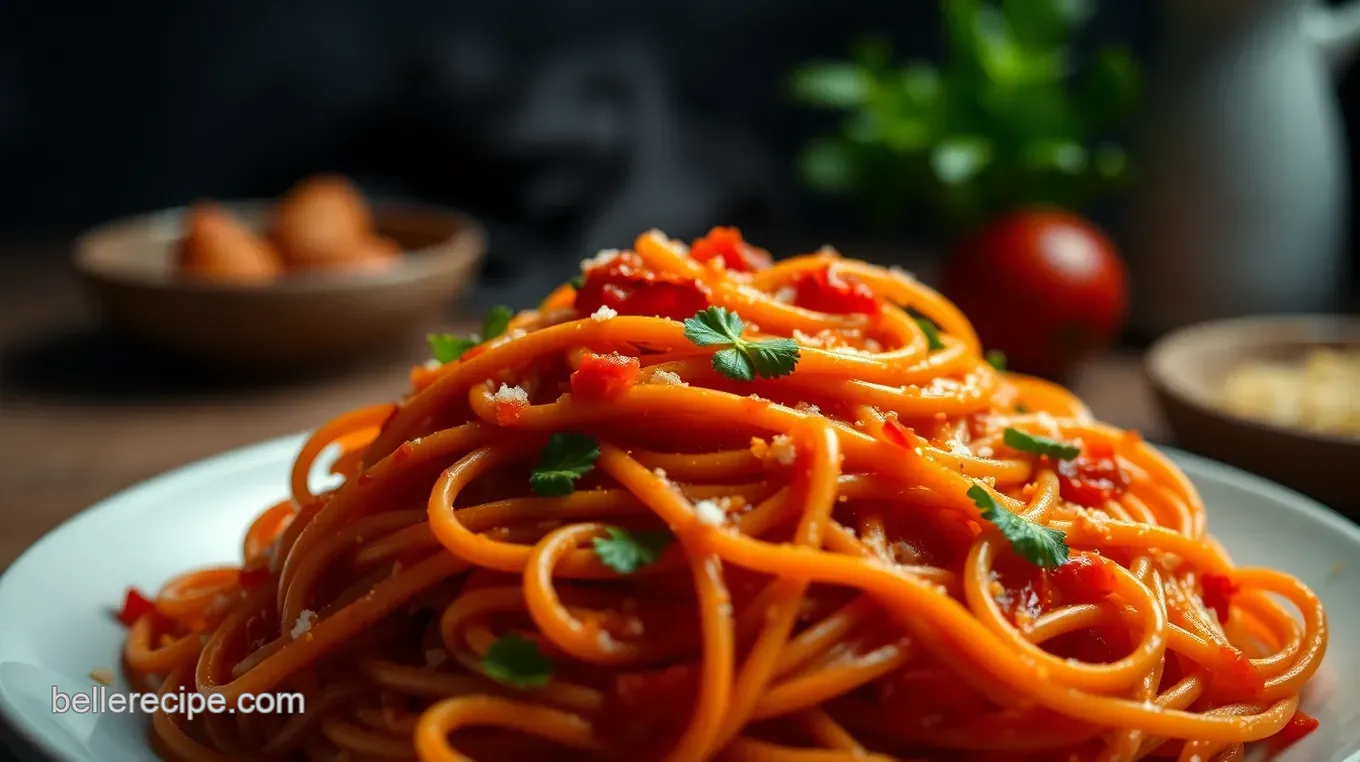
- look into into Deliciousness: Gochujang Pasta Awaits!
- Cooking Through Time: A Brief Recipe Overview
- Why You Should be Making This Gochujang Pasta
- Your Ultimate Ingredients Guide for Delicious Dishes
- Mastering the Art of Cooking: Professional Techniques for Delicious Gochujang Pasta
- Unleashing the Flavors of Gochujang Pasta: Pro Tips & More!
- Frequently Asked Questions
- Recipe Card
look into into Deliciousness: Gochujang Pasta Awaits!
Oh my gosh, let me take you back to one of those evenings where i was just staring into my fridge, and it felt emptier than a taco bell at 10 a.
M. you know, the type where you're thinking, “is there anything that doesn’t involve takeout?” that’s when i discovered the magic of gochujang pasta .
Seriously, a spicy twist on your classic spaghetti? it’s an asian dish that’ll blow your mind, i promise!
Now, here’s the deal with gochujang —it’s this korean chili paste that brings a delightful mix of heat and sweetness.
When you toss it with your pasta, it’s like a culinary hug that warms you up from the inside. this recipe isn’t just about filling your belly; it’s a flavor fiesta in your mouth.
I can’t even begin to tell you how those rich, fermented notes from the gochujang sauce turn an ordinary meal into an extraordinary dining experience.
Cooking Through Time: A Brief Recipe Overview
Let’s talk about the roots of gochujang . this spice has traveled through korean history like a slow dance—dating back to the 18th century! traditionally, it was made with just three ingredients: red chili powder, glutinous rice, and fermented soybeans.
Fast forward to today, and it’s found its way into all kinds of modern cooking—like our gochujang pasta delight.
Now, if you’re wondering how to tackle this dish, good news! it’s a medium difficulty level. don’t be intimidated! you’re looking at about 25 minutes total of prep and cook time—just enough for a quick weeknight dinner or a fancy date night.
And let me tell you, the yield is enough to feed four hungry friends or enough leftovers for the next day’s lunch (score!).
As for costs? A typical gochujang recipe won’t break the bank. You’ll probably find most ingredients sitting in your pantry already, which makes this whole process even sweeter!
Why You Should be Making This Gochujang Pasta
Now, let’s get into the nitty-gritty of why you absolutely need this spicy gochujang pasta in your life. first off, health benefits! gochujang is packed with antioxidants, and let’s be real, any meal that packs a punch of flavor is better than plain old spaghetti.
It’s low in fat and can be easily tailored into vegan gochujang noodles or a vegetarian gochujang recipe just by choosing your noodles wisely.
This dish is perfect for parties! if you’re having a gathering or celebrating, everyone loves something interesting to try. serve this up with some zucchini side dishes or even some cheesy sides, and watch your friends go wild.
Plus, it’s a unique spin compared to other common pasta dishes like the classic vodka sauce pasta . with its bold flavors, it makes every meal an adventure.
And if you’re still on the fence, know this: this isn't just another pasta dish. the gochujang pasta sauce will leave your taste buds dancing with joy.
That sweet and spicy combo just isn’t something you experience every day, and honestly? you can show off a little, saying, “yeah, i made this!”
So if you’re salivating at the thought of trying out this fusion of flavors, grab your apron. We’re getting ready to dive deep into that ingredient list and whip up something fabulous together!
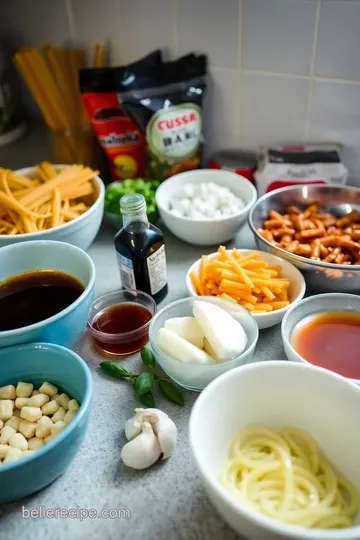
Your Ultimate Ingredients Guide for Delicious Dishes
Welcome to your go-to guide for creating scrumptious meals, like spicy gochujang pasta delight ! cooking can feel overwhelming, especially when trying to gather all your ingredients.
But fret not! i’m here to help you navigate the essentials and bring some chill vibes to your kitchen. you ready to spice things up? let’s go!
Premium Core Components
When you’re whipping up dishes, having the right ingredients is key. Here's how to make sure you're on track.
-
Detailed measurements: think of it as your kitchen’s gps. use 12 oz (340g) of spaghetti for that perfect bite. a trusty scale is handy— metric and us measurements help keep you on point.
-
Quality Indicators: You know that moment when you pick up an onion and it just feels right? Look for firm, unblemished produce. Freshness equals flavor!
-
Storage guidelines: keep your pantry organized! dry goods like pasta can hang out for 1-2 years . fresh produce? not so much.
Store it properly, and it’ll last—like, be the longest-lasting friendship ever!
-
Selection Criteria: Don’t just grab any old thing when you're at the store. Choose organic when possible ; it often tastes better and gives good vibes!
Signature Seasoning Blend
Now that you’ve gathered your core ingredients, let’s jazz it up with some flavors.
-
Essential Spice Combinations: Think garlic, soy sauce, and, of course, gochujang . This Korean chili paste brings the heat! If you're digging Asian dish recipes, this is your playground.
-
Herb Selections: Try adding fresh cilantro or parsley to brighten things up. Herbs are like the musical notes in your cooking symphony!
-
Flavor Enhancers: Feeling adventurous? Toss in sesame oil; it’s like a hug for your taste buds.
-
Regional Variations: Your spaghetti can totally channel its inner fusion star. You can swap in zucchini noodles for a fresh twist. You know, keeping it healthy!
Smart Substitutions
Oops, running low on an ingredient? No worries!
-
Common Alternatives: No gochujang? Use sriracha mixed with miso paste. It’ll pack a punch in your choice of gochujang recipes .
-
Dietary Modifications: Veggies in the mix? Vegan gochujang noodles work just as well without fermented goodies. Easy-peasy!
-
Emergency Replacements: Don’t have soy sauce? Balsamic vinegar to the rescue!
-
Seasonal Options: Keep it fresh! Use seasonal veggies in your pastas. Those summer tomatoes? Yes, please!
Kitchen Equipment Essentials
Alright, now let's make sure you've got your kitchen gear covered!
-
Must-Have Tools: You’ll need a big pot for boiling your spaghetti and a saucepan to cook up that gochujang pasta sauce . Check, check, double-check!
-
Alternative Equipment: No saucepot? A deep skillet works just fine. Be flexible, my friends!
-
Preparation Tips: Always have a sturdy wooden spoon handy. Seriously, they’re like the MVPs of kitchen tools!
-
Storage Solutions: Invest in some good glass containers for leftovers. Because let’s be real: leftover gochujang pasta is basically the best kind of snack.
Let’s Get Cooking!
Equipped with your list of essential ingredients, smart substitutions, and kitchen tools, you're set to create that spicy gochujang pasta delight .
So grab your apron, channel your inner foodie, and let’s get into the nitty-gritty of cooking that vibrant dish. cooking can be a blast, especially when you're armed with knowledge and a pinch of creativity! happy cooking, friends!
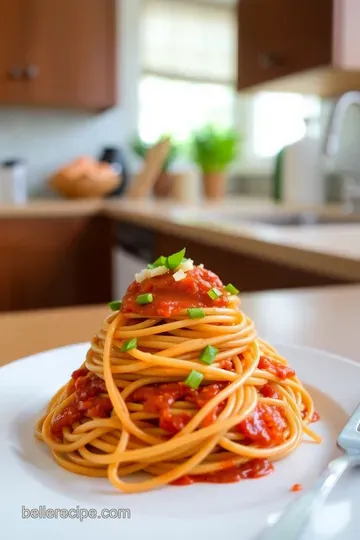
Mastering the Art of Cooking: Professional Techniques for Delicious Gochujang Pasta
So, you’re about to dive into the wonderful world of professional cooking? awesome! whether you’re whipping up a quick dinner for yourself or hosting folks for a chilled-out night, having a handle on professional cooking methods can totally elevate the experience.
Grab your apron; we’re jumping into the essential steps and processes that will get you on your way to serving up a killer plate of gochujang pasta !
Essential Preparation Steps
First off, let’s talk mise en place . this fancy french term just means “everything in its place.” before you even think about stirring a pot, gather all your ingredients for the spicy gochujang pasta delight .
Measure out your 12 oz of spaghetti and keep your 2 tbsp of gochujang ready to go! having everything prepped and ready saves time and makes you feel like a pro.
Trust me; it’s an absolute game-changer.
Now, let’s chat about time management . you have 10 minutes to prep and 15 minutes to cook. it sounds like a race, but once you get the hang of it, you’ll feel like a culinary ninja.
Organize your workspace; use bowls for chopped ingredients and keep your utensils within arm’s reach. it’ll cut down on unnecessary running around.
Safety is key in the kitchen, especially if you’re working with heat and sharp knives. keep a towel nearby to wipe spills, and always remember, don’t leave the stovetop unattended.
Trust me, once you get that pasta boiling, you won't want to wander off and let it turn into gooey mush!
Step-by-Step Process
Now for the fun part: making your gochujang pasta ! Here’s a quick rundown of what to do:
-
Cook the pasta : bring a pot of salted water to a rolling boil (around 212° f ) and toss in your spaghetti.
Cook until al dente —about 8- 10 minutes —then drain it but save that pasta water ! it’s liquid gold for your sauce later.
-
Prepare the sauce : in a saucepan over medium heat, stir together gochujang , soy sauce, sesame oil, honey, minced garlic, and grated ginger.
Cook this mix until it’s fragrant—about 2 minutes .
-
Simmer and thicken : add your vegetable broth and let it simmer for 3- 5 minutes . as it bubbles, slowly mix in your cornstarch slurry (that’s just cornstarch and water) until the sauce thickens.
You'll want it cozy, not too runny.
-
Combine and serve : toss your drained spaghetti right into the pan with the sauce, and mix it up! if the sauce is too thick, add a splash of that reserved pasta water.
Garnish with sliced green onions and sprinkle some toasted sesame seeds.
Look out for those visual cues : you want that sauce to have a nice coating consistency—think of how tasty it looks on those Cheesy Gochujang Noodles you might’ve seen on Instagram!
Expert Techniques
As you gain confidence, you can start using some professional techniques to enhance your dish. one super important step is to constantly taste as you go.
This helps you find that magic blend of sweet, spicy, and savory. adjust your levels of gochujang, depending on how wild you’re feeling! if it gets too hot, a splash of cream or coconut milk can cool things down.
Success Strategies
Let’s wrap this up with a few success strategies to ensure your gochujang pasta is a hit! common mistakes? forgetting to save that pasta water is one.
Use it wisely to keep that sauce from being too heavy. also, don’t hesitate to play around with ingredients. toss in some seasonal veggies or protein if you want extra heartiness!
And if you need to prep ahead of time, the sauce hangs out well in the fridge. just warm it up while you boil your pasta for a quick weeknight dinner.
It’s all about making it your own!
Additional Information
So, whether you're hosting a casual dinner or just craving something spicy, this gochujang pasta recipe is your ticket to impressing anyone at the table! plus, with all the variations—like turning it vegetarian or even trying a vodka sauce pasta spin—you’ll never get bored.
Now let's dive into some additional information about cooking with gochujang and maybe explore easy variations for those cozy nights in!
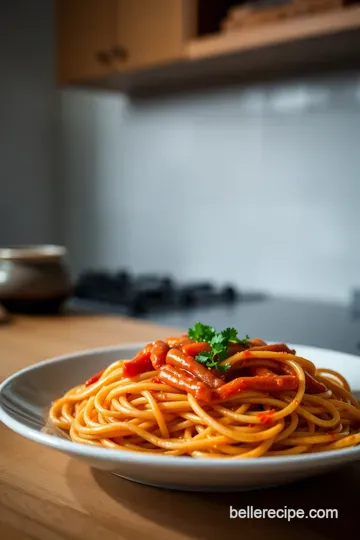
Unleashing the Flavors of Gochujang Pasta: Pro Tips & More!
Oh my gosh, folks! if you haven’t tried gochujang pasta yet, you are seriously missing out. this dish is a game changer! not only does it bring together fiery korean spices and the comfort of classic italian noodles, but it’s also super easy to whip up in your kitchen.
With a few pro tips and tricks, you’ll be strutting around like the next top chef in no time.
Pro Tips & Secrets
-
Chef’s insight : honestly, the key here is to master the flavors. don’t be shy! taste as you go. that beautiful balance of sweet, spicy, and savory is what makes this dish sing.
A little more gochujang? go for it!
-
Time-saving techniques : got a busy day? no worries! cook your pasta ahead of time. you can then toss it with the sauce when you're ready.
Boom! dinner is served in under 15 minutes.
-
Flavor enhancement : looking for that extra something-something ? try adding some toasted sesame seeds or a drizzle of sesame oil before serving.
Adds a ton of flavor and makes everything look snazzy.
-
Presentation advice : remember, we eat with our eyes first. when plating, twist that pasta into a beautiful nest or pile it high in the center of the plate.
Trust me, a sprinkle of green onion on top makes everything pop!
Perfect Presentation
Okay, let’s chat about plating. It might sound fancy, but honestly, you want your dish to look as good as it tastes.
-
Plating Techniques : A simple swirl or stack can elevate your dish. Use a fork or tongs to create a beautiful peak of that wonderful gochujang pasta .
-
Garnish ideas : fresh herbs can do wonders. a sprinkle of cilantro or some finely chopped green onions adds a nice touch.
If you’re feeling extra trendy, toss on some crispy shallots or nori flakes !
-
Color Combinations : We love color! Think about adding vibrant veggies like bell peppers or even some colorful cherry tomatoes to your dish. It’s like a rainbow on your plate!
-
Visual Appeal Tips : Use a clean white plate to really make those colors pop! The contrast will turn simple gochujang dinner recipes into a feast for the eyes.
Storage & Make-Ahead
Now, let’s get real practical. Sometimes you just want to make life easier, right?
-
Storage Guidelines : If you’ve got leftovers (if that ever happens), store in an airtight container in the fridge. Just make sure to seal it well to keep that flavor intact!
-
Preservation Methods : You can freeze the sauce for later use. Just pop it in a freezer-safe container. It’ll keep for about three months!
-
Reheating instructions : when you’re ready to enjoy your gochujang pasta , just reheating on the stovetop will bring it back to life.
Add a splash of broth or water to loosen it up—no one likes dried-out pasta.
-
Freshness Duration : This dish can last about 3-4 days in the fridge, but let’s be honest, it won’t last that long once word gets out about your cooking!
Creative Variations
The beauty of gochujang pasta is how versatile it is!
-
Flavor Adaptations : Want a kick? Add more gochujang. Not spicy enough? Toss in some red pepper flakes for an extra zing.
-
Dietary Modifications : This can easily be a vegetarian gochujang recipe ! Toss in some roasted veggies or swap in gluten-free pasta to suit your needs.
-
Seasonal Twists : Using seasonal produce adds a personal touch. Imagine spring veggies with a fresh twist!
-
Regional Variations : Love a little crunch? Add some crushed peanuts or cashews for that Asian twist!
Complete Nutrition Guide
If you’re like me, you want to know what’s in that delicious pasta, right?
-
Detailed Breakdown : For one serving of your gochujang recipe pasta , you’re looking at around 320 calories , which isn’t too shabby for a filling meal.
-
Health Benefits : Gochujang isn’t just super tasty; it’s got health benefits too! That fermented goodness can aid digestion, and it’s a good source of antioxidants.
-
Dietary Considerations : Watching sodium? You might want to look for low-sodium soy sauce. There are tons of options out there!
-
Portion Guidance : Being mindful of your portion sizes helps too! This serves about four, but feel free to adjust.
So, what are you waiting for? look into into this exciting gochujang pasta recipe , and let's be honest—this isn’t just cooking; it’s creating a delightful experience.
Trust me, your taste buds will thank you! keep things fun in the kitchen, add your twist, and enjoy every delicious bite.
Happy cooking!
Frequently Asked Questions
What is gochujang pasta made of?
Gochujang pasta is primarily made with spaghetti or linguine tossed in a spicy and sweet sauce featuring gochujang, soy sauce, sesame oil, and garlic. It’s a fusion dish that brings together the comfort of traditional pasta with the bold flavours of Korean cuisine, making it a unique and tasty meal alternative.
How spicy is gochujang pasta?
The spiciness of gochujang pasta largely depends on the amount of gochujang you use. Generally, it has a mild to medium heat, but you can easily adjust the spice level by adding more or less of the chili paste to suit your palate. If you're sensitive to spice, starting with a smaller amount is a great idea!
Can I make gochujang pasta vegan?
Absolutely! To make a vegan version of gochujang pasta, just ensure you use vegetable broth and replace any honey with maple syrup or agave nectar. This dish is already quite adaptable, so feel free to add in your favourite veggies for an extra crunch!
What are some good variations of gochujang pasta?
There are loads of variations you can try! Add grilled chicken or shrimp for protein, tossed seasonal veggies like bell peppers or spinach for added nutrition, or even mix in a dollop of cream cheese for a creamy texture. You could also serve it cold as a pasta salad—perfect for summer!
How should I store leftover gochujang pasta?
Store any leftover gochujang pasta in an airtight container in the fridge for up to 3 days. When reheating, you might want to add a splash more vegetable broth or water to bring back some moisture, as the pasta absorbs the sauce over time.
Is gochujang pasta healthy?
Gochujang pasta can be a healthy dish depending on your ingredient choices. It uses whole food ingredients and can be packed with vegetables. The nutritional profile varies, but it’s rich in flavor with a good mix of carbohydrates, protein, and healthy fats, and you can easily adjust the sauce to suit dietary needs.
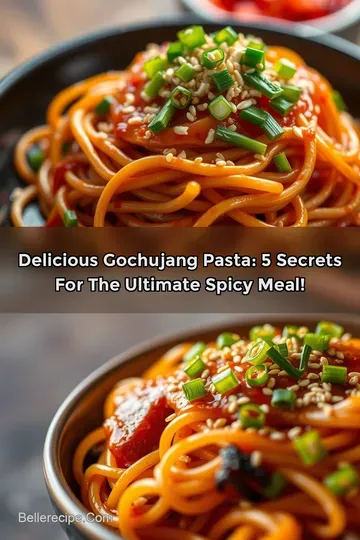
Spicy Gochujang Pasta Delight Card

⚖️ Ingredients:
- 12 oz (340g) spaghetti or linguine
- Salt (for pasta water)
- 2 tbsp (30ml) gochujang
- 2 tbsp (30ml) soy sauce
- 1 tbsp (15ml) sesame oil
- 1 tbsp (15ml) honey or maple syrup
- 3 cloves garlic, minced
- 1-inch piece fresh ginger, grated
- 1 cup (240ml) vegetable broth
- 1 tbsp (15g) cornstarch mixed with 2 tbsp (30ml) cold water
- 2 green onions, sliced
- 2 tsp (10g) sesame seeds (toasted)
🥄 Instructions:
- Step 1: Boil salted water and add the spaghetti. Cook according to package instructions until al dente, then drain (reserve 1 cup pasta water).
- Step 2: In a saucepan, combine gochujang, soy sauce, sesame oil, honey, garlic, and ginger. Stir over medium heat until fragrant (about 2 minutes).
- Step 3: Pour in the vegetable broth; simmer for 3-5 minutes.
- Step 4: Slowly add the cornstarch mixture while stirring to thicken the sauce.
- Step 5: Toss the drained pasta into the saucepan, mixing well. Adjust the consistency with reserved pasta water if needed.
- Step 6: Plate the pasta, garnish with green onions and sesame seeds.
Previous Recipe: Classic Chicken Parmigiana Sandwich: The Ultimate Comfort Food
Next Recipe: My Family's Favorite Seasoned Rice Recipe: Easy Herb-Infused Delight
